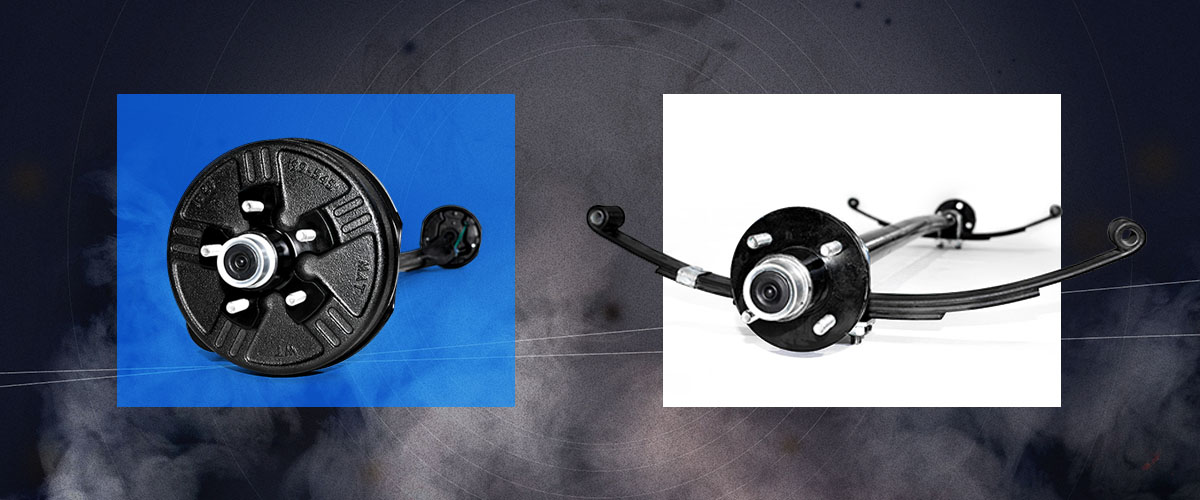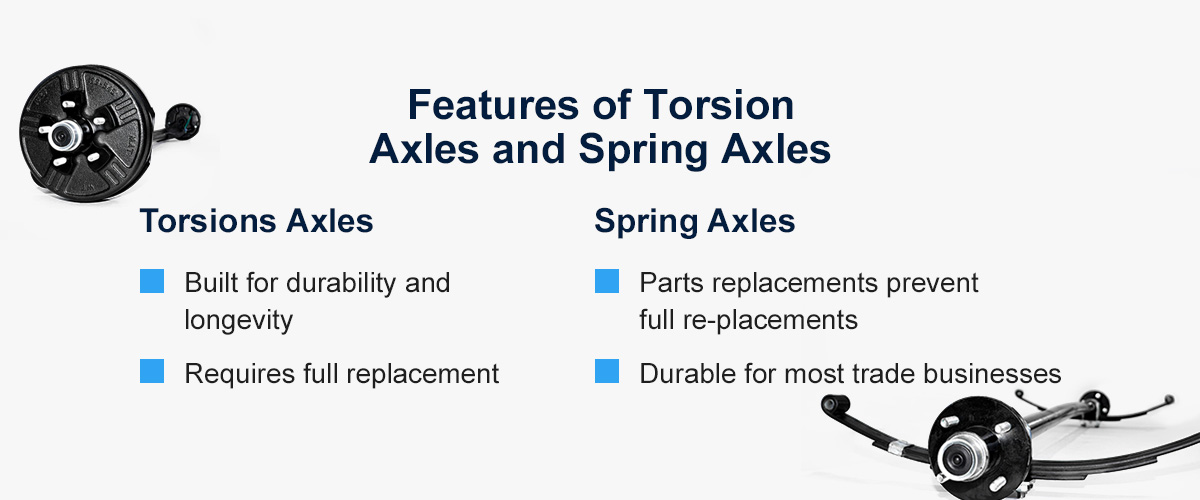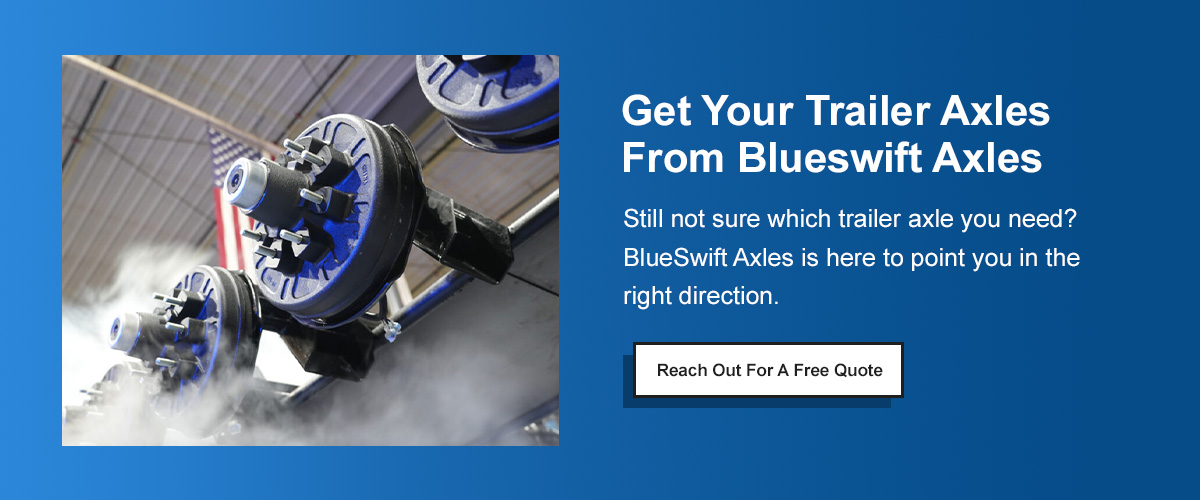When looking for a new axle for your trailer, the first thing that pops up in your mind is the type of axle you should buy. There are two main types of axles — spring axles and torsion axles. Choosing the right axle for your trailer depends on several factors. To help you understand the difference and make the right choice, we dive into the spring vs. torsion trailer axles debate to give you clarity.
Torsion vs. Spring Trailer Axles
Spring axles are the more common and easy-to-recognize trailer axles, and they’re generally the cheapest to maintain and install. The spring trailer axle is made of curved metal spring leaves — giving it the name spring axle. The load rating determines the number of leaves in the spring construction.
Torsion trailer axles have no spring leaves, which is one of the major distinctions between the two types of trailer axles. The torsion axle has a square cross member mounted across the width of the trailer. Inside the square cross member, there is a square inner bar and four rubber cords that allow the wheel to move up and down.
Now that you know the main difference between torsion and spring trailer axles, you need to know the strengths and drawbacks of each type before deciding which one to use.
Torsion Trailer Axles
Advantages of torsion trailer axels include:
- Longer warranty periods
- Removable spindles in case of blowouts of the bearing
- Less maintenance
- Range of arm articulation that allows for smooth raising or lowering of the trailer clearance
- Less bumpy or bouncy ride
- Independent wheel suspension
- Can be welded or bolted to the trailer frame
Some disadvantages of these axels are:
- Higher initial cost
- The rubber inside the axle may stiffen in colder weather
- Not available in many repair facilities
Spring Trailer Axles
Advantages of spring trailer axels include:
- Lower initial cost
- Easier to repair
- Readily available parts
- The interlinked axle system prevents load spikes
Some disadvantages of these axels are:
- Shorter warranty periods
- Bounces a little more than the torsion axle when the trailer is empty
- Additional moving parts require more maintenance with time and use
Features of Torsion Axles and Spring Axles
Let’s consider some key features of torsion axles vs. spring axles that can also help you make the right choice. The advantages and disadvantages section listed some of these features.
Torsions Axles Built for the Long Haul
- Built for durability and longevity: Do you need to carry heavy loads over long distances? High-capacity torsion trailer axles will likely be your best bet. Torsion axles turn your trailer into a workhorse, giving you the ability to haul livestock, large lumber loads, woodchippers and even some car trailers. Moreover, torsion axles can handle the stress of large loads and still maintain their durability. Expect these axles to be long-lasting even if you are a high-mileage hauler. The tradeoff for that durability comes in the form of a difficult-to-maintain part. Like the Torflex system, our torsion arm suspension is completely self-contained inside the axle tube.
- Requires full replacement: This means the components are sealed inside and hard to access. Because of this, torsion axles may need to be replaced more frequently. The interior construction means less outside wear and tear from the elements — however, you will need to do a full replacement when the axle has reached its full wear. This could be from distance, use or age. The average life expectancy of a trailer axle is between 3-5 years.
Spring Axles Offer Reliable Low Maintenance
- Parts replacements prevent full re-placements: If it seems like spring trailer axles are more common, there is a good reason for that. Spring axles offer the versatility that haulers require while having the advantage of being easy to maintain. Spring axles have easy-to-replace components located externally. For general wear and tear, you can update parts rather than replace the entire axle. The springs and suspension on spring axles are readily accessible and replaceable from the outside, saving both time and money when replacements for these components are necessary.
- Durable for most trade businesses: Yet, these axles are still durable enough to support the hauling of landscaping trailers, roofing trailers, car trailers and more.
Can I Switch My Axle Type?
You may be wondering if it’s possible to replace a spring trailer axle with a torsion trailer axle or vice versa.
Yes, but the process requires a professional to weld and change the setup. If you’re switching for the durability of use, make sure the cost benefits outweigh the installation expenses. Before you start seriously considering one type of axle over another, it’s important to know which one you already have. That 3,500-pound spring axle you’re eyeing may have a lower price point, but if your trailer currently uses a torsion axle, that price can easily go up.
Switching from a torsion axle to a spring axle is more complicated than a straight swap, and the labor cost to go from one to the other can exceed the cost of sticking with the same axle type. Even if you determine that you’re willing to undertake the added effort of switching, you’ll need to know whether you already have the best type of axle for your needs or not.
Which Axle Is Right for Your Trailer
Your choice of trailer axle depends on several factors, the most critical factor being the gross trailer weight. The gross trailer weight includes the maximum cargo weight plus the weight of the trailer. Adhering to these weight limits in your purchase decision is non-negotiable. You should also consider the type of loads you’ll be carrying. Concentrated loads such as heavy machinery require a different axle setup from an evenly distributed weight like gravel.
You should also familiarise yourself with the following terms when shopping for a tailer axle:
- Load rating: This is the maximum weight the axle can safely handle.
- Track length: This is the distance between the axle and the tire’s centers.
- Spring center: This is the spacing between spring mounting points on the axle.
You must comply with legal and regulatory requirements in your areas of operations. Overloading a trailer beyond its rated capacity can lead to penalties and also pose safety risks on the roads.
Get Your Trailer Axles From Blueswift Axles
Still not sure which trailer axle you need? Blueswift Axles is here to point you in the right direction. Get advice on the right axle for your trailer from Blueswift Axles, where 48-hour axles are made. Give us a call at 515-606-1943 to get assistance with your order or reach out online for a free quote today.


